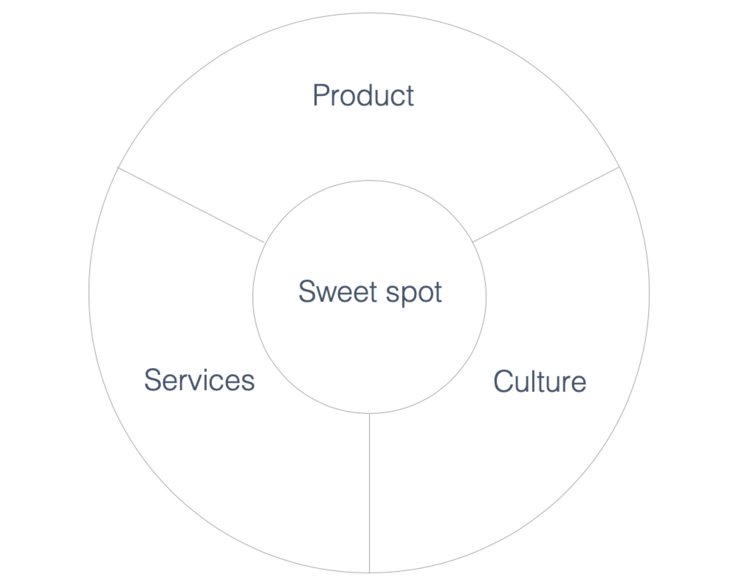We began ‘Let’s Talk About’ by asking how brands can create a connection with consumers and remain relevant in today’s crowded marketplace. Across four articles we’ve scratched only the surface of how brands must connect and build loyalty – the brand ‘sweet spot’ of success.
Brands have never before communicated across as many types of media, as much, as rapidly, or as often as they do now. This has put huge pressure to deliver experiences that hit the mark, that connect.
Our series explores the deeper reasons that come to define the ‘sweet spot’ occupied by a brand, through the intersection of product, service and culture. We termed this, the ‘sweet spot’, the place a brand builds an authentic message across every touchpoint and deliverable – but is all too often forgotten in pursuit of growth. By trying to be too many things for too many people, brands can lose sight of their core focus: what makes the brand special and how to build brand experiences around it.
(Graphic: AK Brand Experience)
Sometimes it's necessary for a brand to have difficult conversations and to be realistic about expectation. A great way to do this is to dive into the shoes of the customer and identify the areas where the brand misses the mark in terms of consumer attraction. Spending time with those already passionate about the brand as well as those who are not. Dissecting brand expectations and matching them against customer reality at every stage.
Start with the message and simplify it.
(Source: expatrepublic.com)
We use the ‘sweet spot’ to streamline this. It sounds simplistic, and it is, two questions are paramount:
How can we create a meaningful connection with our target consumer?
How does this speak to our existing consumers and is there a disconnect?
Todayʼs consumer demands authentic brand experience. In a post-ownership world, building rich, engaging experiences is more important than ever. By focusing on the three pillars that make up brand experience (Product, Service and Culture) brands can create clear, consistent communication and experiences that attract consumers and gain trust.
Product
(Source: lifestyleasia.com)
A brand is ultimately here to connect and sell. Brand product output can be segmented into the following categories:
Origin product
Bespoke and collaborations
Enhance lifestyle offer
Companies like Gucci, Microsoft and Mattel have stayed close to their original purpose – with diversification serving to compliment the origin product. When brands move too far beyond their core offer, they risk losing that intuitive connection with customers. Famously, Kodak’s detour into pharmaceuticals only lasted six years and the range of yoghurts created by Cosmopolitan magazine is best left forgotten.
So how can a brand grow, build in choice to cement and maintain appeal, while staying true to their original intent?
Successful bands develop their range from a place of authenticity, bolting on product categories that complement and enhance the origin offer. They seek collaborations with like-minded designers or brands. Possibly the most stratospheric example of this is the mega-brand collaboration of Nike and Michael Jordan, which generated a staggering $3.1 billion in 2018 alone.
This level of celebrity association has given rise to connected brand associations. Vuitton answered their much-publicised copyright spat with Supreme by inviting them to collaborate on a product release. This generated much fanfare, garnering huge publicity not only via the products but also by the queues outside boutiques globally ahead of the launch.
Customers no longer connect to a distant celebrity advertising a product they know they don’t really use. Arguably social media has transformed the very idea of celebrity through the power of influencers. Consumers trust them because they build a personal connection and it’s here that brands are leveraging this power. Indeed influencers like Kylie Jenner and Huda Kattan have gone on to launch eponymous brands both valued at over a billion dollars.
Service
(Source: Stock Unlimited)
Service puts the world in your hands. Every aspect of our world, from calling a cab, ordering food, heating our homes and not only making a humble shopping list – but the way we receive the groceries we order has changed dramatically.
Service can be segmented into these main areas of delivery:
Expected
Unexpected
One step beyond
Nothing has changed our understanding and interaction with service as much as the smartphone. Former Burberry Chief Angela Arhedts said of today's consumer that they ‘wake up, pick up their mobile device and then life begins’. On nightstands around the world, consumer’s first service interaction with brands sits there waiting for them to wake up.
Burberry is arguably one of the most digitally savvy brands around. After reviewing their online offer, they concluded that it delivers a service experience ‘just as rich, just as exciting as any store’. Indeed, their digital store ultimately helped shape the future of Burberry’s Maison designs – seamless, digital-first.
This groundswell of change has ensured service will never look the same again. But how does this affect brand experience? How can brands focus on human interaction to drive growth?
Culture
(Source: Batesmeron)
Culture can be understood with a more current term: purpose. But what is purpose? How can it be defined and more importantly, what is the ‘sweet spot’ for delivering purpose with heart? In a world more connected than ever, a clear definition of purpose helps consumers navigate the noise and align themselves with like-minded people, brands and organizations.
Culture can be separated into three main areas of delivery:
Purpose
Localisation
Giving back
TOMS and Warby Parker are two brands that display what it means to have brand culture and purpose built into their core. TOMS defines its origin story as; ‘While travelling in Argentina in 2006, TOMS Founder Blake Mycoskie witnessed the hardships faced by children growing up without shoes. Wanting to help, he created TOMS Shoes, a company that would match every pair of shoes purchased with a new pair of shoes for a child in need.’
Warby Parker works with nonprofits such as Vision Spring to donate one pair of glasses for each pair sold to improve access to glasses worldwide and has already reached one million people in need. Both brands speak about their reason to exist and their product reflects their purpose.
While not all brands are built on such an ethical foundation, this clarity around purpose echoes across every area, every touchpoint, every communication, every product and every happy consumer of brands that connect.
Culture is connective and brands must nurture the authenticity of their message. They must act with cultural responsibility to define their purpose, shaping everything from product sourcing through to the way teams talk with consumers. Brands have evolved to learn that for consumers to genuinely connect, they must act with the same desire and passion to shape the world as the consumers themselves.
Brands deliver perfect brand experiences by creating a culture inside that radiates out. It's here the brand ‘sweet spot’ is completed. Product, service, unified by culture.
(Source: curatti.com)
So the ‘sweet spot’ is connection?
We define the ‘sweet spot’ as authenticity, it comes to define every experience we take from a brand’s delivery.
Brands must continue to build rich, engaging and exciting experiences – online and offline. The ability to adapt rapidly and speak to a multitude of consumer types is driving this transformation and rightly so. Brands forget the human at their peril. Service is powered by and for the consumer, the human and no matter how much technology helps simplify consumers lives, it’s connection that’s essential.
While digital has been the 21st-century driver of change, genuine, authentic human connection is paramount – it’s local, knowledgeable and understanding. It’s here that the ‘sweet spot’ of service can be found.
In ‘Let’s Talk About…’ Ales Kernjak shares invaluable insight, tips and tricks that draw from his extensive experience in retail as well as predictions for its future. Upcoming articles cover all aspects of today’s retail landscape, from product experience to culture, visual merchandising to store design and much more. Follow the series on Brand Experts.







